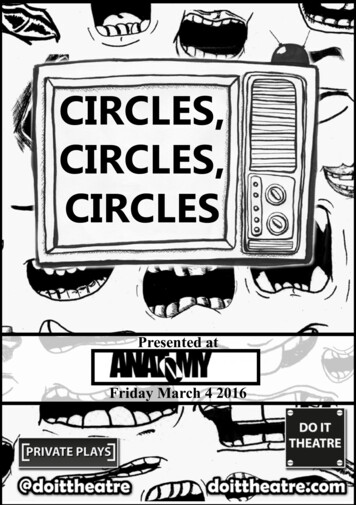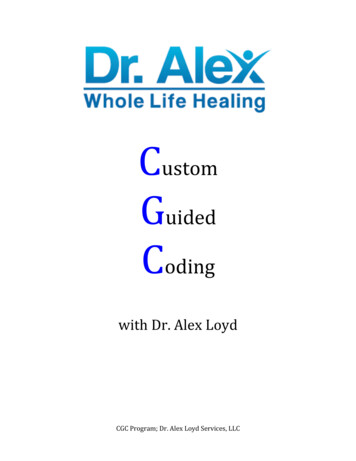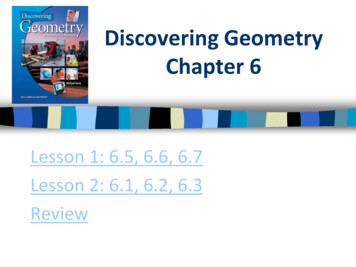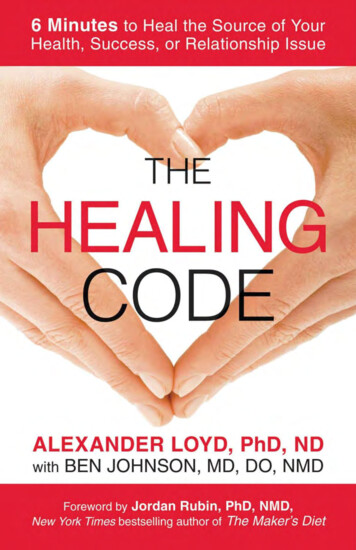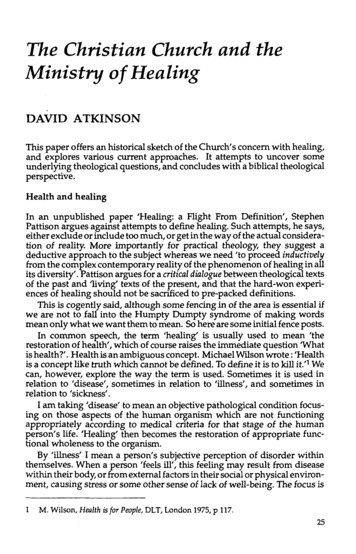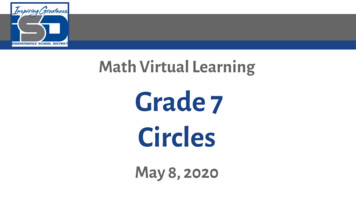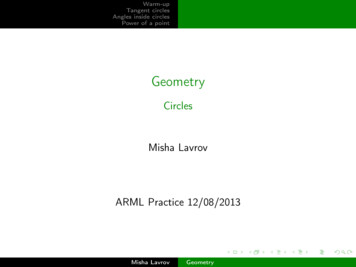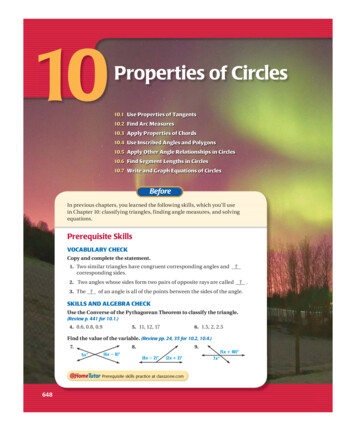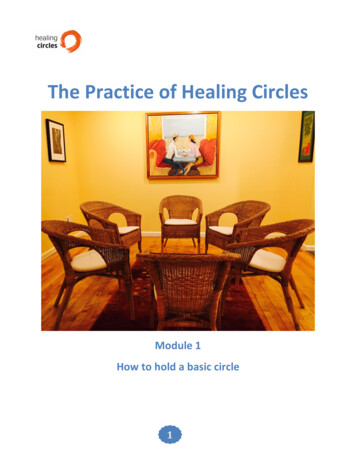
Transcription
The Practice of Healing CirclesModule 1How to hold a basic circle1
About this GuideThis Guide is an introduction to Healing Circles for those interested in hosting a basic healingcircle. This is the first in a series of guides, designed to increase your skill in being a circlehost/guardian or take you deeper into the circle experience.Who might benefitThis Guide can be used by individuals on their own or can be used in a groupsetting. For groups, the guide includes a range of activities—reading, reflecting,sharing, discussing—for a range of circle sizes.How long will it take?If you are reading this on your own, take time to reflect on each question andreturn once you’ve arrived at an insight. If you are working with a group, you arealways welcomed and encouraged to adapt these guidelines to meet your circle’sneeds and available time.Table of Contents1 What are Healing Circles? 32 Preparing for Circle53 Welcome94 Heart-sharing155 Harvesting186 Closing the Circle202
1 What are Healing Circles?Circle started around the cook-fires of humanity’s ancestors and hasaccompanied us ever since. We remember this space. When we listen,we speak more thoughtfully. We lean in to shared purpose.Christina Baldwin, author, The Circle WayWhat is a circle? There is a difference between meeting in a circle and invoking or calling a circle.The circle is the mother of methodologies: the Campfire that our ancestors gatheredaround to build tribe and clan.A circle is also a living entity, a full-bodied presence that we are creating together.The circle is an invitation is to discover a deeper way of being together, protected byagreements which we’ll discuss later.“If it touches your heart & guides you on your path,it’s a Healing Circle.”Michael Lerner, president, CommonwealWhat are the hallmarks of a Healing Circle? Healing Circles help us step out of ordinary time into a safe and accepting environment inwhich each of us can explore our own healing.With open hearts, we access our own inner guidance to understand where the greatesthealing—in body, emotions, mind and spirit—can occur.With open minds, we work together to discover the best ways to remove obstacles tohealing, alleviate suffering, and deepen our capacity to heal.3
Individual Reflection followed by a Circle of Two:Have you personally felt the healing power of a circle? Reflect on what made it healing.2 minutes individual reflectionYour experienceHow does a Healing Circle work?Circle practices help us become more aware of how wecommunicate with others—whether family, friends,partners, co-workers, or fellow circle members. Thesepractices help us to be kinder and more respectful ofeach other and ourselves. Key to a magical circle are theagreements (see page 13).Circles can have many different formats. This guidedescribes a simple, sample format for a healing circlethat includes four sections—a Welcome, a Heart-Sharinground, a Learning round, and a Close. You are welcometo adapt it to your circle’s needs. Healing Circles arefunctional blends of mechanics and magic. Themechanics are necessary to establish and maintain asafe, conducive environment for magic to emerge. Thetrick in a Healing Circle is to be vigilant of the balancebetween the two—to avoid over-emphasizing one at theexpense of the other.For more informationBooks Christina Baldwin and Ann Linnea, The Circle Way Parker Palmer, A Hidden WholenessOnline resources About Healing Circles: are-healing-circles/ About The Circle Way: www.thecircleway.net About the Center for Courage and Renewal: www.couragerenewal.org4
2 Preparing for Circle“The impulse to share the healing experience— to help others face whatwe have faced—is built into the human psyche. As Rachel NaomiRemen puts it, “we heal in community.” For many people, a keydimension of healing is to work in a circle of companions who shareyour wound and share your strong intention to find healing.Healing is a movement toward wholeness – physical, emotional, mentaland spiritual. Healing is different from curing – when an illnessdisappears, never to return. Healing can take place both in a movementtoward recovery and, equally, when losing ground physically. Greathealing can also take place in dying.Michael Lerner, president, CommonwealIF YOU’RE STARTING A CIRCLEWhy are you calling a circle?There are many reasons to call a circle but a Healing Circle is typically born out of love and adesire for service. Discovering your own purpose is a vital first step which you can return to as atouchstone again and again.Individual Reflection: Why are you calling a circle? Where does hosting this circle fit inyour life? How does it serve your soul/own wholeness?5 minutes (or as long as it takes)5
Who will hold the circle? Healing Circles provide the safest experience for circle members when there are at leasttwo people supporting the circle, Host and Guardian. (For a description of these roles,please see page 14.)Having a team of co-hosts is also best for sustaining the circle: either can host the circlewhen the other is unavailable. At those times, you can invite a circle member to act asGuardian.It’s also more fun and more fulfilling to work as a team of co-hosts. The load is lighter, thelearning deeper.Individual Reflection: Who would you enjoy co-hosting the circle with?1 minuteCircle of Two: Share your ideas for what makes an effective, working relationship betweenco-hosts? How can you support each other?6 minutes6
What is the intention of the circle?Circle of Two: What is the intention of the circle?1-5 minutesWho will you invite and how will you reach them?Circle of Two: Who would you like to welcome into the circle and how will you invite them(if known)/reach them (If unknown)?1-5 minutesWhere will you hold the circle?Circle of Two: Where will you hold the circle?1-5 minutes7
FOR ALL CIRCLES: PREPARING THE SPACECIRCLE OF 2: How would you like to prepare the physical space so people feel welcomeand safe?3 minutesTips for hosts and guardians Create a beautiful welcoming space that is clean, well-lit, and has comfortable chairsCreate a center for the Circle – candle, flowers, or symbol(s) of your work together.Make a checklist to remind yourself before every circleChoose from any of the ideas below or add your own:Send a reminder to the circle membersWelcome them with tea or beveragePrepare the space with comfortable chairs and a center for your circleSet an intention for the circle with your co-host (if the intention varies)Gather whatever pieces you’d like to add to the circle: aquote/poem/passage/meditation/music/art, etc. in this circle?You’re ready! Take a big breath and prepareto welcome people into your first circle.8
WelcomeBeing welcomed into circle has four key components.1Welcoming, the informal connection that starts to build between one human being andanother from the time we come in the door until we sit down in circle.2Entering the Circle, the transition space that enables us to leave behind the worldwe’ve come from and enter the circle with full attention and presence.3Introducing/Check in—If the group is new or a new member has joined, make time forbrief introductions. Returning circles often start with a brief check-in.4Understanding Circle Agreements & Practices, making sure everybody in the circlehas a shared understanding of how the circle works.1. WelcomingGroup Discussion: What makes you feel welcome when you enter a new space? What isthe value of social time in a Healing Circle?5 minutesTips for Hosts The Welcome begins at the door with a smile, and for a returning member who would likeone, a hugLight refreshments, perhaps a cup of teaA comfortable chair in a clean, well-lit placeCircle set up with a center, either a candle, flowers, or other object9
2. Entering the CircleCircles often begin with a simple ritual.123Light a candle in the centerRing a bell signifying the beginning of silence and ring one at the endRead a quote or poem (such as the one below)True solitude is found in the wild places, where one is without humanobligation.One's inner voices become audible. One feels the attraction of one'smost intimate sources.In consequence, one responds more clearly to other lives. The morecoherent one becomes within oneself as a creature, the more fully oneenters into the communion of all creatures.Wendell Berry, from his poem “Healing”Individual reflection: What was your experience of this way of entering a circle?2 minutesGroup discussion: What is the role of silence in entering a circle?2 minutesTips for Hosts Silence has many advantages:o Creates a safe container or sacred spaceo Provides a pause, a separation between what came before and what comes aftero Connects us to inner guidance10
Silent Council is when we each look inside and listen carefully to what is most importantto us right now. We might experience this as a welling of intuition, a grace. Communicationsin a silent council can also come to us in the form of imagery, sensations, voices, or othermeans of communicating with our bodies, minds, and spirit.When we’re on our own, we can also hold a Circle of One, a circle for different voiceswithin.o These might be conflicts that arise between the roles we play in life—for example,being a parent vs. working late at the office.o We might be experiencing a range of emotions and have difficulty naming them andworking with them in turn.o An inner council can also be held by personifying different organ systems within thebody—for example, is the liver at risk from the therapy for the lung?Group discussion: What other ways of Entering the Circle might you and your groupchoose to use?3 minutesTips for HostsCircles can be enriched with different ways of being and learning together if the group feelscomfortable with them. These might include: Guided meditation—Our pain circle always begins with guided meditation. The circle viewsthis as skill-building. Guided visualization—Our cancer circle has requested a visualization that they can use ontheir own. Reading—In addition to the host and guardian, different members of the circle can bring indifferent prose passages or poems to read to the group. Music—Circles whose members enjoy singing could sing or those who enjoy listening coulduse a piece of music as an introduction3. Introducing/Intention/Check-inWhenever there are new people in a circle, it is helpful to begin with Introductions to circle members Introduction to circle agreements and practices Introduction to the timing/theme/agenda of the circle today11
Introductions for new circles or new membersGroup discussion: What is the purpose of introductions?2 minutesGroup discussion: For ongoing circles, how can you vary introductions based on thepurpose of your circle each time?2 minutesTips for Hosts The key purpose of introductions to get everyone’s voice in the room as early as possibleand as comfortably as possible.Introductions can serve many purposes and you can tailor them each circle. Here are somesuggestions, but please use your own creativity.IF YOUR INTENTION IS TOMake people comfortableYOU MIGHT TRY THISWhat’s your name and what brings you tothis circle?[For a cancer circle] We’ll have theopportunity to learn more of our stories in aminute but let’s begin by simply saying whattype of cancer we have and when we werediagnosed.[Ask people to bring a sacred object withthem to circle] How does your sacred objectrepresent who you are in the context of thiscircle?What brought you joy when you were young?What is your intention for this circle?What’s a one-word weather report for howyou are feeling today?Orient each other to a common conditionEstablish sacred spaceCreate common bondsSet intentionBring members into the present12
4. Understanding the Circle Agreements and PracticesWhy Agreements?Group discussion: Why do we have agreements?3 minutesTips for Hosts Circle agreements protect the safety of the individuals and the integrity of the circle.What are the Healing Circle Agreements? We treat each other with kindness and respect.We listen with compassion and curiosity.We honor each other’s unique ways to healing and don’t presume to advise or fix or try tosave each other.We hold all stories shared in the circle confidential.We trust each of us has guidance we need within us and we rely on the power of silence toaccess it.Group discussion: Do you have any questions about these agreements? Does your groupwant to modify or add to them?As long as it takesTips for Hosts The Healing Circles agreements used at Healing Circles Langley were derived from manysources. Your group is free to adapt them to meet your needs. See these sources for otherideas:o PeerSpirit, The Circle Wayo Parker Palmer, Circle of Trust Touchstones13
What are the Circle Roles of Host/Guardian? The Host and Guardian perform service, not leadership, roles in the circle.If we continued the campfire metaphor, the Host is responsible for tending the fire(protecting the center): starting the fire and keeping the fire going without the fire gettingout of control. The Host opens and closes the circle and might direct the transition fromone segments of a circle to another. The Host is usually not there to be a subject matterexpert.Metaphorically, the Guardian is responsible for protecting the rim of the circle, makingsure no one gets burned by being too close to the fire, and keeping an eye on those who feelthe need to back away from the heat. Practically, the Guardian watches the energy of agroup, protects the safety of the circle by ensuring agreements are kept, and rings the bellfor silence. According to The Circle Way, creators of the Guardian role, “The guardianusually employs a gentle noise-maker, such as a chime, bell, or rattle, that signals toeveryone to stop action, take a breath, and rest in a space of silence.” The Host andGuardian sit opposite each other to ensure sightline to everyone in the circle.Circle members both tend the fire and protect the rim. All participants shareresponsibility for holding the circle and for their own healing.Any member may call for the bell to initiate a pause.14
Heart-sharing“The soul speaks its truth only under quiet, inviting, and trustworthyconditions.”― Parker J. Palmer, Let Your Life Speak: Listening for the Voice of Vocation“The work of seeing is done.Now practice heart-work ”Rainer Maria RilkeThe core of the Healing Circle is the Heart-sharing round(s) where each person in turn has theopportunity to speak to what is most on their heart in the moment. At its most sacred, this is amoment of authenticity, vulnerability, and often self-discovery.The Mechanics: Talking Piece CouncilAt the invitation to enter the Heart-sharing round, all members direct their attention to the centerof the circle, and then look within. When someone is ready to begin, they pick up a talking piece—which can be a rock, a symbol, or anything the group prefers—and begin to talk. When they’refinished, they pass the talking piece to their right or left. That person is free to take a moment tosee if they’d like to share right now, and if not, they can pass the piece to the next person.The MagicWhen we speakWe speak to the center of the circle, we put our metaphorical log on the fire. We use the time tocenter on our intention for this time in circle, exploring what is most alive in us. This is where wemove toward our own wholeness, our own healing.“The most basic and powerful way to connect to another person is tolisten. Just listen. Perhaps the most important thing we ever give eachother is our attention.”Rachel Naomi Remen15
“The best way to help others heal is not to tell them what they shoulddo. Rather, you start with generous listening. As Parker Palmer, thegreat Quaker educator, puts it: Do not advise them. Do not to try to fixthem. Do not to tell them what they should do. Do not try to be wise orshow off your expertise in healing. Simply be there for them, a witnessto their exploration of their own path.”Michael Lerner, Intentional HealingWhen we listenThe rest of circle listens without interruption or comment. We bear witness to the joys, thestruggles, hopes and fears of another and so see ourselves. We don’t take on each other’s pain.Again, using the campfire metaphor, we can pull close to the fire, receiving the heat we need, or wecan back away from the fire if we need to.Question for Heart-sharing round: What is most on your heart today?Each member of the circle shares and then passes the talking piece to the nextperson. That person is free to pass or share.Group discussion: What are some of the challenges of Talking Piece Council and howwould you work with them?15 minutes16
Tips for HostsThinking through some ideas for working with common challenges in the Heart-sharing round canincrease your confidence in being a host: Lack of self-regulation whether because of lack of awareness, physical limitations (such asblindness or hearing loss), medications (such as steroids), or another reasonWhat ideas do you have for how to work with this situation? Not speaking authentically whether because of fear, a desire to please, a lack of selfknowledge, cultural norms, gender norms, or another reasonWhat ideas do you have for how to work with this situation? Not being kind or respectful for whatever reasonWhat ideas do you have for how to work with this situation? Going off point—outside the intention of circleWhat ideas do you have for how to work with this situation?17
Harvesting“We are exploring together. We are cultivating a garden together,backs to the sun. The question is a hoe in our hands and we are diggingbeneath the hard and crusty surface to the rich humus of our lives.”― Parker J. Palmer, Let Your Life Speak: Listening for the Voice of VocationResearchers are still studying what makes social support such a critical and powerful element ofhealing. One focus has been on the practical—someone to help get you to a doctor and help withphysical needs. Another focus has been on the quality of the emotional support that was justevident in the Heart-sharing round. Another focus is on how the social network deliversinformation needed for healing. The Harvesting round is intended to give space for this learning totake place. Harvesting can be done using many different formats and practices. Your group willfind its way if you give it time.The MechanicsFormats and practices Personal—We go around the circle again using the talking piece, this time each in turntakes their own discovery process deeper by speaking to what they have harvested fromthe previous round.Small group—The group can divide into areas of interest—good for a large circleWhole circle—The circle explores questions using two different circle practices:Popcorn Councilo Talking-piece variation where we don’t go around in circle but rather anyone canshare their thoughts, without cross-talk or follow-up questions.o Used to get ideas out quickly, e.g., brainstormingo Used for harvesting experience in large groups where not everyone needs to shareo Used to report individual reflection where not all will want to shareConversation Councilo Similar to normal conversation without persuasion or disagreementWays of transitioning Host, Guardian, or group decides to continue with their individual learning from theprevious round and just pass the talking piece around againGroup proposes questions they’d like the group to address todayHost synthesizes Heart-sharing round and offers a question18
The MagicThe magic comes from the whole-heartedness of the group. The circle members genuinely want tolearn and the circle respects that each person has their own area of pressing concern.We’ve found these practices keep learning circles magical: Asking deeply relevant, authentic questions that matter in our lives now Answering the question from our own experience Reflecting clearly if we need further clarification to understand someone else Asking open and honest questions of each other if a person asks for direct helpTypical Harvesting Round question: What do we want to learn from the wisdom in thegroup today?2 minutes: Each member of the circle identifies a questionTips for Hosts Honor the collection of inner wisdom before priming occurs in the group by having amoment of silence or the opportunity to write a question down.Harvesting to find universals or collectives may or may not ultimately be of value to theone. Beware of group think.Group discussion: What are some of the challenges of Conversation Council and howwould you handle them in circle?15-30 minutesTips for HostsBecause conversation is how we normally interact with each other, we can easily fall into habits.Take some time to think about how you would address these situations in circle: Trying to fix or save Trying to impose a belief system on another Dominating or interrupting a conversation Not giving time to the quiet voices in the room Believing you know what’s best for another19
Closing the Circle"We clasp the hands of those who go before us,and the hands of those who come after us;we enter the little circle of each other's arms,and the larger circle of lovers whose hands are joined in a dance,and the larger circle of all creatures, passing in and out of life,who move also in a dance, to a music so subtle and vastthat no one hears it except in fragments." Wendell Berry, excerpt from his poem "Healing”Leaving the circle unwinds how we entered. Your circle is free to create its own rituals but theyusually include three elements: a check-out, silence, and the blowing out of the candle.Check outTypical check-out question: In one word or sentence, what are you leaving with fromtoday’s circle? What is percolating inside that you’d like to continue to work on?One minute eachSilence between bells May start with a poem or song before ringing the bell for silenceCandle outThis guide has been prepared by Healing Circles Langley based on our collective experience. We aredeeply grateful to Christina Baldwin and Ann Linnea of PeerSpirit and to Michael Lerner ofCommonweal for developing the foundation of this work. Other healing circles are welcome to useand adapt this guide under Creative Commons principles. This is draft 3.0—we welcome your inputto make it better. Please send suggestions to dianalindsay@healingcircleslangley.org.20
Remen puts it, "we heal in community." For many people, a key dimension of healing is to work in a circle of companions who share your wound and share your strong intention to find healing. Healing is a movement toward wholeness - physical, emotional, mental and spiritual. Healing is different from curing - when an illness
